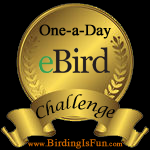2011 started a bit slow for me, and I only had four trips that required air travel--2 weeks and 2000 miles driving the entire coast of Texas in May, a conference in Ohio, a quick family wedding trip to Oregon, and a conference in New Zealand in December. Since I didn't enter all my Texas trip sightings into eBird (ooops!), I'm not sure exactly how many birds I saw this year (that's why you have to enter everything you see into eBird!). eBird has my total as 250, so I probably saw something over 400. Not a huge number. But having moved to NJ this fall, I've already wracked up 127 species in my new home county, and 67 species in my new yard in the past three months. So some fun birding at home, nearby, and on some good trips this year.
That said, here were my best birds of 2011
10) Gray-hooded Gull. I got to chase this unexpected vagrant on Coney Island with my kids. One of only two new birds for my North American bird list this year.
9) Wrybill--a cool New Zealand shorebird with a bill that bends to the side. I was able to get distant looks at three of these on muflats out near the Auckland Airport.
8) Tui--one of the more common native New Zealand land birds, seemingly doing fairly well even in city parks and yards. Think of a crow-like bird with white chest tufts and a iridescent lacey shawl. Very loud and cool. And New Zealand even has a ketchup named after it--Tuimato Sauce!
7) White-faced Storm Petrel--Still haven't seen this one out in the Atlantic off the East Coast, but when I was in New Zealand I got to see over 500 of them out in the Hauraki Gulf. Very cool sea bird that skips across the waves. Hopefully this summer I can connect with one on a pelagic trip here in North America.
6) Kokako--I hadn't even heard of this rare bird before preparing for my New Zealand trip. Turns out they are extremely endangered, and only maybe 1500 are probably left. I was able to see a handful of these gray crow-sized birds with blue wattles on Tiritiri Matangi Island across the harbor from Auckland.
5) Little (Blue) Penguin--My first penguins! I saw two of these birds huddled in a specially made penguin nesting burrow on Tiritiri Matangi Island.
4) Pink-footed Goose--after chasing this one a few times over the years, I finally got one on one of my old stomping grounds in Bucks County, PA. Thanks to August Mirabella for finding the bird and the internet for getting the word out quickly so I could drop everything and get this bird! My only other new ABA bird for the year.
3) Brown Kiwi--I didn't see this bird in the wild, but did get video of one in the Auckland Zoo. I have to go back down to New Zealand to see these guys (and their two or four other related kiwi species, depending on which expert you believe).
2) New Zealand Storm Petrel--last observed in 1850 and thought extinct, a few of these birds were rediscovered in the Hauraki Gulf near Auckland in 2003. We were able to see at least 3 of them on a pelagic trip there on December 10. It was worth getting seasick for!
1) Takahe--There are less than 300 of these large flightless New Zealand rails alive in the world. I saw Greg the famous tame Takahe on Tiritiri Matangi island, but also several more of his more wild cousins there as well.
Honorable mentions--Snowy Owl with my kids, White-collared Seedeaters on the banks of the Rio Grande in Laredo, Red-cockaded Woodpeckers in the Piney Woods of Texas, displaying Buff-breasted Sandpipers on the Texas coast. Too many to mention, really.
So, while I may not have seen a huge number of birds this year, but I am grateful for all I did see, and there were some great ones. What were your best birds of 2011?
Here's to an awesome year of birds and birding in 2012!
Swift Departures
17 hours ago


















































